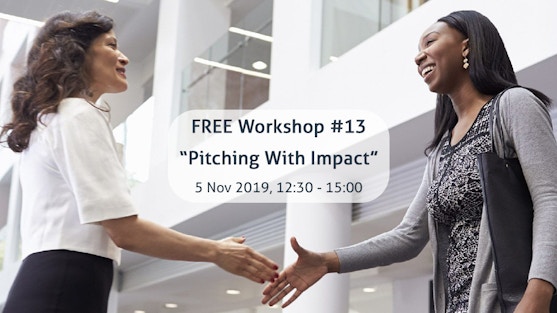Post | November 2019 | Past workshops | 5 min read
5 November 2019 - "Pitching With Impact!"

In work and in life, we need to sell - sell our ideas, sell our goals, sell ourselves. We do this every day in ways big and small, and we do it through the art of the pitch. Making a pitch is a way to persuade others to believe in what you believe in. When you sell yourself and your skills at a job interview, trying to persuade hiring managers why you're the best person for the job, you make a pitch. When you're trying to get your boss to implement one of your fantastic ideas, you make a pitch. It is only through pitching our ideas that people will hear us out, adopt them, and believe in our solutions. But making an effective pitch can be tricky! When pressed to answer the question, "What are you looking for," you need to craft a short, powerful, and convincing answer, often on the spot. At our seventh workshop of 2019, pitch coach Frank Smallegange taught us that pitching is a skill - and like any other skill, it needs to be honed and practiced. To that end, we learned all about what goes into an effective pitch, and even had the opportunity to craft our own personal pitch!
Frank Smallegange coaches "Pitching With Impact" attendees on 5 November 2019
At the beginning of our recent workshop, “Pitching With Impact!”, pitch coach Frank Smallegange, speaking to a full house of local expats and internationals, went over the importance of using the art of the pitch to promote products and services to customers, clients, organizations, and more. He explained that these audiences may indeed need what you are offering, but often this need isn’t at the forefront of their consciousness. In giving a pitch, one’s job is to make your audience realize that they have a need, and to present what you have to offer as an asset to fulfill that need.
“But what if you’re presenting a person,” one attendee asked. It was the first question of the workshop.
“I know it’s a little strange to think about,” Frank said, “but people are products.”
In other words, when pitching yourself – as a potential employee, for a promotion, for an assignment, and so on – there is no substantial difference in technique from when a salesperson is pitching a product to a customer. And this makes perfect sense; often when we are pitching ourselves and our skills or ideas, we’re doing so in a professional context where we are receiving some kind of benefit in exchange for what we have to offer – whether that be a salary in employment, new skills through an internship or volunteer opportunity, or excellent grades when proposing an assignment at school. When looking at the art of the pitch from this standpoint, we can see how much we actually use this skill in our lives, and how important it is to apply the “5 P’s of Pitching” that Frank discussed at the workshop: “Practice, practice, practice, practice, practice.”
The Kenn Adams Story Spine
Frank is not only a pitch coach – he’s also a performer and improv master. Why is that important? “Humans are natural storytellers,” he says – and making a pitch is just like telling a story. To that end, Frank introduced the Kenn Adams Story Spine to us, which is a method of crafting well-structured stories. In a series of sentence prompts, Frank set attendees to work crafting brief stories, and it was a delight to hear all of the unique stories that our attendees came up with!
So, how does this story spine work? As the photo illustrates, it’s a series of sentence fragments that form the spine of a story – from the beginning, where you paint the picture as it is now; to the climax, where something is introduced that changes everything; to the conclusion, where a new paradigm is put in place for the future. But how does this apply to pitching? According to Frank, pitching also has its own structure that runs parallel to the story spine!
- Once Upon A Time: The usual environment/situation/condition of your audience
- Every day: What happens because of this situation; here, highlighting the disadvantage your audience currently faces – their “pain,” if you will – is key! Highlight their pain, make it impactful, but don’t exaggerate too much.
- Then one day: What will happen when your solution or skill is injected into the situation?
- And because of that: Further benefits and applications of your solution
- So now everyday: The environment/situation/condition of your audience post-solution
- And ever since then (The End): Your call to action – what do you want your audience to do? Frank says this is usually a good place to start planning your pitch. Once you have your call to action crafted, it’s much easier to come up with a pitch that is highly focused.
Participants at "Pitching With Impact!"
Finally, Frank walked us through the important consideration of audience. He pointed out that there’s a hierarchy of possible audiences you’ll have when making a pitch. “Ambassadors” don’t directly need your services or ideas, but they know people who do; they’re 95% of the audiences you’ll encounter (and why networking skills are also so important!). Next are the “Influencers,” who have the ability to influence the final type of audience – the “Decision Makers.” This final type of audience are the people who actually have the power to say “yes” or “no” to your pitch. The higher up this hierarchy you go, the more important it is to have a focused, efficient, refined pitch to present to them. But even among these audiences, there are so many types of people out there; how can we possibly know how to come up with effective pitches for all situations? Frank advises that, when crafting your pitch, pretend that you’re explaining your product or service to at least three types of people: for example, to three different age groups, such a child, a teenager, and an elderly person. Take what is best about each of these explanations and inject them into your final pitch. With that, you should be able to craft a pitch with a wide sense of emotion, excitement, and appeal so that it may be appropriate for any audience!
We want to thank Frank for his insightful and enthusiastic presentation. And, as always, we want to express our gratitude to our wonderful attendees for their participation in this workshop. We hope that you not only learned some new skills but also had a great time doing it! We love hosting these workshops for our amazing expat community, and we very much hope to see you again at our future events!
About the Presenter
.jpg)
Frank Smallegange a pitch coach for (technical) start-ups. He has extensive work experience as a designer and builder at various IT companies. In addition to this, he is a master of improvisation and storytelling. To gain this experience, he took courses all over the world, from Las Vegas to Berlin. This unique combination of experiences means that Frank not only understands what a pitch is about, but also that he knows how to skillfully relate to and engage with an audience - one of the most important aspects in making a pitch!





